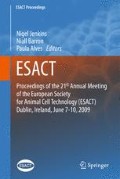Abstract
Cell line misidentification results in the use of a model system derived from a different species or tissue or individual to that claimed. The accidental and fraudulent use of misidentified cell lines has contaminated a significant proportion of the scientific literature for over 50 years. Cheap and reproducible methods such as STR profiling are available to identify the problem and authenticate individual cell lines. Every laboratory needs to adopt the new standard being developed by the ATCC.
Access this chapter
Tax calculation will be finalised at checkout
Purchases are for personal use only
References
American Type Culture Collection Standards Development Organization Workgroup ASN-0002. Cell line misidentification: the beginning of the end. Nat Rev Cancer 10: 441–448 (2010).
Coriell LL. Detection and elimination of contaminating organisms. Natl Cancer Inst Monogr 7: 33–53 (1962).
Defendi V, Billingham RE, Silvers WK, Moorhead P. Immunological and karyological criteria for identiication of cell lines. J Natl Cancer Inst 25: 359–385 (1960).
Dirks WG, MacLeod RA, Drexler HG. ECV304 (endothelial) is really T24 (bladder carcinoma): cell line cross-contamination at source. In Vitro Cell Devl Biol 35: 558–559 (1999).
Editorial. Responsibility for trust in research. Nature 289: 211–212 (1981).
Gartler SM. Genetic markers as tracers in cell culture. Natl Cancer Inst Monogr 26: 167–195 (1967).
Gartler SM. Apparent HeLa cell contamination of human heteroploid cell lines. Nature 217:750–751 (1968).
Gey GO, Coffman WD, Kubicek MT. Tissue culture studies of the proliferative capacity of cervical carcinoma and normal epithelium. Cancer Res 12: 264–265 (1952).
Gold M. A conspiracy of cells. One woman’s immortal legacy and the scandal it caused. State University of New York Press, Albany, New York, NY (1986).
Goldenberg-Furmanov M, Stein I, Pikarsky E, Rubin H, Kasem S, Wygoda M, Weinstein. Lyn is a target gene for prostate cancer: sequence-based inhibition induces regression of human tumor xenografts. Cancer Res 64:1058–66 (2004).
MacLeod RAF, Dirks WG, Matsuo Y, Kaufmann M, Milch H, Drexler HG. Widespread intraspecies cross-contamination of human tumour cell lines. Int J Cancer 83 : 555–563 (1999).
Masters JRW et al. STR profiling provides an international reference standard for human cell lines. Proc Natl Acad Sci USA 98 : 8012–8017 (2001).
Muñoz M, Rosso M, Aguilar FJ, González-Moles MA, Redondo M, Esteban F. NK-1 receptor antagonists induce apoptosis and counteract substance P-related mitogenesis in human laryngeal cancer cell line HEp-2. Invest New Drugs 26 : 111–118 (2008).
Negoro K, Yamano Y, Fushimi K, Saito K, Nakatani K, Shiiba M, Yokoe H, Bukawa H, Uzawa K, Wada T, Tanzawa H, Fujita S. Establishment and characterization of a cisplatin-resistant cell line, KB-R, derived from oral carcinoma cell line, KB. Int J Oncol 30: 1325–32 (2007).
Nelson-Rees WA, Flandermeyer RR, Hawthorne PK. Banded marker chromosomes as indicators of intraspecies cellular contamination. Science 184: 1093 (1974).
Nelson-Rees WA, Daniels DW, Flandermeyer RR. Cross-contamination of cells in culture. Science 212: 446–452 (1981).
Paruchuri S, Sjölander A. Leukotriene D4 mediates survival and proliferation via separate but parallel pathways in the human intestinal epithelial cell line Int 407. J Biol Chem 278: 45577–45585 (2003)
Ren C, Li L, Goltsov AA, Timme TL, Tahir SA, Wang J, Garza L, Chinault AC, Thompson TC. mRTVP-1, a novel p53 target gene with proapoptotic activities. Mol Cell Biol 22: 3345–3357 (2002).
Takahashi K, Sawasaki Y, Hata J, Mukai K, Goto T. Spontaneous transformation and immortalization of human endothelial cells. In Vitro Cell Dev Biol 26: 265–274 (1990)
Tyson-Capper AJ, Europe-Finner GN. Novel targeting of cyclooxygenase-2 (COX-2) pre-mRNA using antisense morpholino oligonucleotides directed to the 3' acceptor and 5' donor splice sites of exon 4: suppression of COX-2 activity in human amnion-derived WISH and myometrial cells. Mol Pharmacol 69: 796–804 (2006).
Tan F, Lu L, Cai Y, Wang J, Xie Y, Wang L, Gong Y, Xu BE, Wu J, Luo Y, Qiang B, Yuan J, Sun X, Peng X. Proteomic analysis of ubiquitinated proteins in normal hepatocyte cell line Chang liver cells. Proteomics 8: 2885–2896 (2008).
van Bokhoven A, Varella-Garcia M, Korch C, Miller GJ. TSU-Pr1 and JCA-1 cells are derivatives of T24 bladder carcinoma cells and are not of prostatic origin. Cancer Res 61: 6340–6344 (2001).
Wong AS, Gumbiner BM. Adhesion-independent mechanism for suppression of tumor cell invasion by E-cadherin. J Cell Biol 161: 1191–1203 (2003).
Author information
Authors and Affiliations
Corresponding author
Editor information
Editors and Affiliations
Rights and permissions
Copyright information
© 2012 Springer Science+Business Media B.V.
About this paper
Cite this paper
Masters, J.R. (2012). Quality Control and Cell Line Cross-Contamination: An Old Problem that Continues To Fester. In: Jenkins, N., Barron, N., Alves, P. (eds) Proceedings of the 21st Annual Meeting of the European Society for Animal Cell Technology (ESACT), Dublin, Ireland, June 7-10, 2009. ESACT Proceedings, vol 5. Springer, Dordrecht. https://doi.org/10.1007/978-94-007-0884-6_35
Download citation
DOI: https://doi.org/10.1007/978-94-007-0884-6_35
Published:
Publisher Name: Springer, Dordrecht
Print ISBN: 978-94-007-0883-9
Online ISBN: 978-94-007-0884-6
eBook Packages: Biomedical and Life SciencesBiomedical and Life Sciences (R0)

